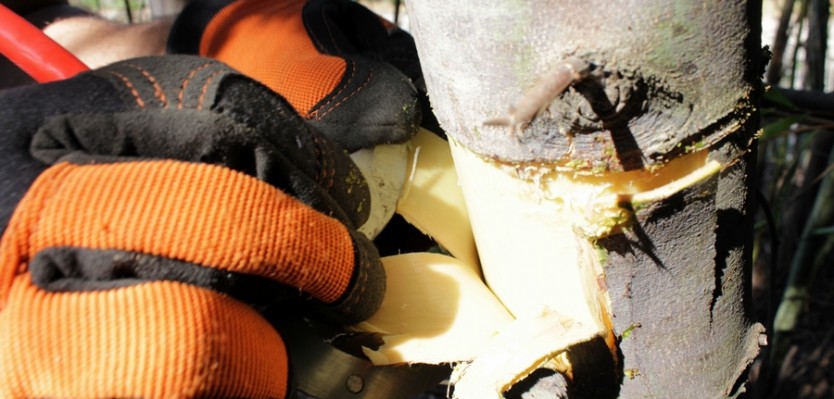
This method is the most appropriate for trees with smooth or unbroken bark. Plants with interrupted, damaged, brittle bark or with prickles should not be debarked.
Examples of the species in which this method may be applied: silver wattle (Acacia dealbata), Australian blackwood (Acacia melanoxylon), other acacias (Acacia spp.), pittosporum (Pittosporum undulatum).
How to do
Make a continuous circular incision (a ring) around the trunk, at the height most comfortable; the incision should cut the bark (phloem and exterior tissues) and reach the wood (xylem), but without cutting the latter.
Remove all the bark (and vascular cambium – “pink pellicle”) from the incision ring down to the soil surface, if possible to the roots, especially for species that stump.
Apply this method only when the cambium is active, which may vary from one place to another. The best application season is with mild temperatures and some humidity – generally in the end of summer or winter – but in some riparianareas it may be applied all year long.
It’s fundamental to evaluate all these conditions before starting a debarking operation!
In trees that aren’t easy to debark, you can leave the plant to grow and attempt it later. Although it’s not necessarily advised to debark in high stress situations (e.g., high dryness), sometimes trees that aren’t able to be debarked completely may end up dying anyway.
Using the debarking method, follow-up and evaluation of results is necessary over several months or years, before applying the method on a large scale.
It’s important to debark all the trees of the invading species in the area of control, as untreated individual plants may facilitate the survival of their debarked neighbors.
Attention: let the plant totally dry up and only then proceed to cut down the tree. The drying may take several months or even years.
This method is very effective when well applied and applied to the right species.
This method can be dangerous for inexperienced operators, as care must be taken with the use of cutting tools.
Can be an easy method for a large groups to perform (e.g., voluntary environmental action groups) and doesn’t demand tools that are difficult to operate.
ÉCan be applied to trees of almost all diameters and, when properly applied, doesn’t stimulate sprouting – not from the trunk or roots – requiring less follow-up control. However, these follow-up is necessary to:
- cut dead trees;
- control plants that survive ;
- control new plants that come from germination;
In the medium-term it’s less costly and is environmentally friendly.
It’s a long and onerous process if performed extensively by professional groups (high amount of manual labor).
It requires thorough application and is only applicable to some species and at certain times of the year.
It needs two interventions spaced over months or even years to control just one tree.
The visual impact of the result of this type of control (standing dried up trees) may have a negative impact on public opinion.
Safety
Attention to your physical working posture and in the handling of cutting tools.
Maintenance
Periodical sharpening of the cutting tools.
Personal Protective Equipment (PPE)
Gloves.
Tools
Bark peeler, ax, saw, knife, pruning shears, and/or a specific cutting tool.


